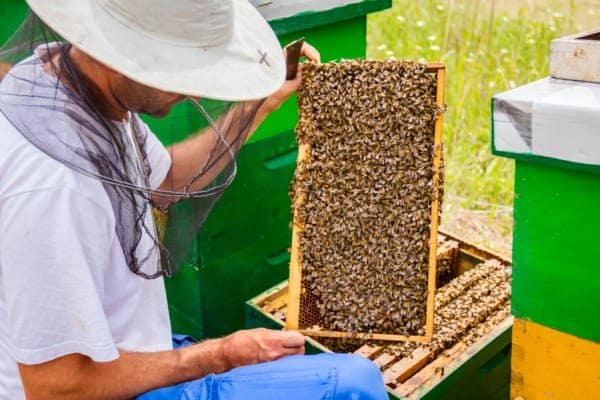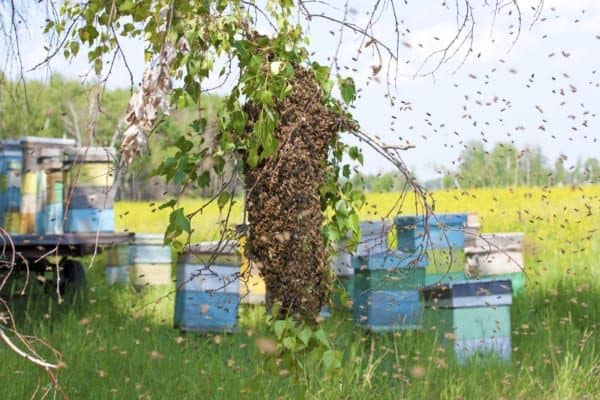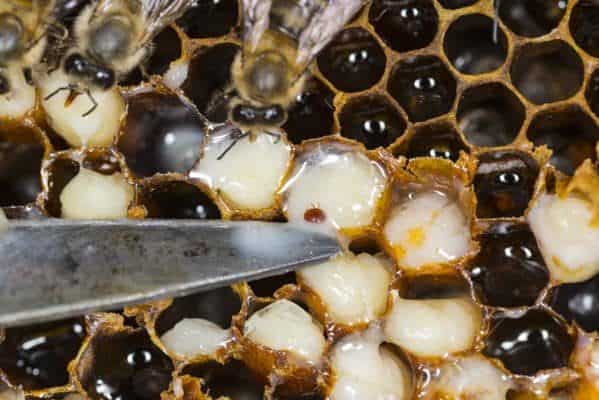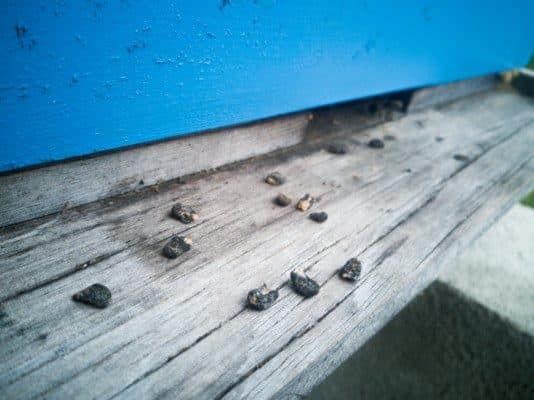Being social insects, honey bees live in colonies, better known as hives. These colonies are eusocial, meaning they consist of a social system where every bee has a specific role i.e queen, worker bees, and drones.
In each colony, you can also find developing eggs, larvae, and pupae in different stages of development.

So how many bees are in a beehive? A healthy hive can reach 20,000 to 80,000 bees during summer. Hive size is influenced by the location of the hive, the age of the hive, the quality of the queen and the availability of nectar and pollen. The number of bees in a hive can be adversely affected by a pest infestation or a disease.
However, some honey bee species may be more prolific in their breeding patterns and characteristics than others.
The Availability Of Nectar And Pollen
Seasonal changes are a crucial factor largely affecting the availability of nectar and pollen, and therefore the number of bees in a hive.
When there is plentiful pollen and nectar, bees work tirelessly to gather as much as quickly as possible to build up stores of honey. The queen lays more eggs to boost the worker bee numbers for the daily tasks of foraging, building wax combs and nursing the increasing brood.
During the nectar flow or honey flow period, when there is an abundance of flowering, hives bloom in population in order to take in as many resources as possible. This happens usually in spring and summer seasons in the temperate climates.
Conversely, when there is a dearth (a situation where food is in short supply), the hive scales down brood rearing and the population drops to such levels that the colony can sustain with the stored honey.
Brood rearing slows down considerably as temperatures begin to drop in fall and the hive prepares for the winter when their energy requirements to keep the hive warm depend entirely on their honey stores.
As a result, the queen will not lay as many eggs as during the nectar flow period.
The Effects Of Hive Location On The Number Of Bees
From tropical, equatorial and temperate to tepid, each climate has a specific effect on a hive and its population.
Tropical Climates’ Effects On The Hive
Tropical climates are characterized by monthly average temperatures of 18°C(64.4°F) or higher year-round. There are normally only two seasons in tropical climates: wet and dry season.
The tropics receive more direct sunlight than other areas and there is very little rain, thus the resulting hot temperatures.
These locations are also blessed with prolonged hours of daylight, allowing hives in these regions to forage more every day virtually all year round.
In saying this, because of the limited rainfall, blooming patterns of flowers may only allow for short but intense bursts of nectar flow.
This would mean a corresponding heightened activity of egg laying by the queen and brood rearing.
The hive is able to sustain a relatively robust population for a considerable time in the absence of any sudden and wider climatic changes as happens in the temperate regions.
Hive Population In Equatorial Climates
The regions and countries intersected by the equator experience much warmer temperatures year-round than the rest of the world, this is despite shared elevations.
The equator is exposed to the sun almost constantly all year long.
Nearly half of the world’s rain forests concentrated in the African nations, Brazil and Indonesia are found on the equator. These countries experience nearly ideal levels of rainfall and sunlight, making large scale plant growth possible.
This in turn translates into profuse flowering of diverse plants over longer periods in the year; meaning honey bees in these habitats have plentiful pollen and nectar most of the time. They are able to breed and sustain robust bee populations for many months of the year.
Temperate Or Tepid Climates’ Effects On Hives
Temperate zones generally include wider temperature ranges throughout the year and more distinct seasonal changes compared to tropical climates where such variations are often small.
The widest seasonal changes occur in temperate climates. These are influenced by the tropics and the poles.
Also, the latitudinal positions, sea currents, prevailing wind direction, continentality (how large a landmass is) and altitude all play a part in shaping the climate of these regions.
In the coldest months, temperatures can drop to as low as minus 3°C (26.6F) or 18°C(64.4°F) During the cold winter season, the hive is in hibernation and dormant. The bees concentrate on keeping the hive warm at a temperature of 35°C to 36°C and brood-rearing all but comes to a standstill.
Most of the male drones would have been kicked out of the hive in fall in order to reduce competition for the honey stores the hive will need to make it through the winter.
During springtime as the temperature warms up and the days grow longer in March, the buildup of colony population picks up. The queen becomes more active and begins to lay more eggs. Although flowers are scarce at this time, demand for food grows and the hive may starve.
In April with the blooming of the flowers bees start foraging. In May there is a pattern of reckless growth for several weeks, limited only by the ebb and flow of nectar and pollen.The beehive population increases dramatically.
This dramatic jump is aimed at one objective: colony-level reproduction which in honey bees happens by a process of colony splitting known as swarming.
At this point, the hive becomes overcrowded as the population exceeds the maximum of 80,000 insects. Of course this depends on how many supers are stacked on the brood chamber of the hive to create the space necessary for accommodating all the said bees.
Swarming
Swarming is a natural reproduction phenomenon that happens in every honey bee colony. In the process, a single colony splits into two or more distinct communities (swarms) when their current hive becomes overcrowded.

This mainly happens in springtime, usually within a two-week or three-week period depending upon the locale. It is not uncommon, though, for swarms to happen throughout the producing season.
How Many Bees In A Swarm?
This depends largely on the strength of the colony. A strong hive of let’s say 60,000 bees can, for example, lose roughly a half of the population with the first main swarm that flies off with the queen.
Other secondary after-swarms or cast swarms are usually smaller and accompanied by a virgin queen. Sometimes this may happen in quick succession to the extent that a hive is almost totally depleted of worker bees.
If you have ever seen a swarm of bees or even and wonder how a beekeeper would catch the swarm, then check out this article we have written on this topic, Bee Removal. How It’s Done and Who Can Do It For You.
The Quality Of The Queen
God bless the ‘queen bee.’ A healthy queen can live up to 5 years and lay 2,000 eggs a day during peak seasons for a few years. This means that the hive will have a strong, productive colony that is able to maintain enough populations of worker bees and raise enough brood.
As the queen ages, her egg-laying ability and prowess may begin to wane and diminish resulting in her laying more unfertilized eggs that hatch into male drones.
Once the worker bees detect this occurrence, they begin the preparation for a new queen as the hive must maintain a balance to ensure a healthy number of female worker bees. A large worker bee population means the hive will grow and thrive.
A common practice in commercial beekeeping is to regularly re-queen hives that appear to be weakening due to poor performance or ageing of the queen. Beekeepers do this in order to maintain high population growth in the hive.
Disease In The Hive
Every healthy bee colony can fall victim to destructive pests or diseases that have the potential to wipe out whole colonies or greatly reduce bee populations in hives.
There are several diseases and pests that affect hives and can prevent it from growing or completely decimate a healthy, robust beehive. Examples of such pests and diseases are:
· Hive beetles
· Varroa mite
· Wax Moths
All this will affect the hive in varying degrees of severity. Let’s now delve briefly into how the health and populations of hives can be affected by these pests.
American Foulbrood
This highly infectious bee disease is caused by the spore-forming bacteria called Paenibacillus larvae subsp. It’s also the most widespread and destructive of the brood diseases. Infection happens when larvae of up to 3 days ingest spores that are present in their food.
These spores will not germinate in larvae over 3days old. Infected larvae normally die after their cell is sealed. The bee larvae darken and die.
If a hive is infected, the spores will rapidly spread throughout the hive as bees, trying to remove the spore-laden dead larvae contaminate brood food.
This quickly weakens and eventually destroys an otherwise healthy hive. The AFB spores are extremely resistant and can remain viable for up to 40 years.
In many states in America, it’s a requirement by State Apiary Inspectors to burn down AFB diseased hives.
Varroa Destructor
This is an external parasitic mite that attacks and feeds on the honey bees Apis cerana and Apis mellifera. The mites cause a disease called varroosis. The varroa mite can reproduce only in a honeybee colony.

By attaching itself to the body of the bee, it weakens the insect by sucking out fat. Varroa Destructor mites can cause honey bees to collapse by spreading viruses and feeding on the fat reserves of adults and larvae.
Chalkbrood
A disease that is caused by a fungus called Ascosphaera Apis, chalkbrood occurs worldwide but affects colonies more seriously in warmer climates.
According to research, the disease is associated with several factors and is most frequently found in bee colonies during the spring, when there are excess humidity and sudden temperature changes in the hive.
It weakens the hive by out-competing the larvae for food and eventually turning the larvae into a “chalk-like” mummy.

Control Of Hive Population By The Beekeeper
In modern beekeeping practice, the beekeeper can control the hive by splitting the hive for two purposes. The first one is to start a new colony in a different hive. That entails the process of removing four or five frames from a healthy hive and transferring them with the brood, pollen stores and worker bees to a new nucleus box or beehive.
This colony division will give the beekeeper a new colony once the transferred bees establish themselves. The second purpose also helps to reduce the hive’s tendency to swarm.
As we have previously mentioned, overcrowding in a hive increases the chances of swarming as a natural action by bees when conditions are right.
So, when the beekeeper steps in and divides an overcrowded hive, it helps to better manage the crowding and he retains bees that build a new colony.
The one bee species that do not have overcrowding problems is the bumblebee.
How Many Bees Are In A Bumblebee Nest?
Bumblebee nests vary in size and are dependent on the species and time of the year. Their nests are small and are found in the ground in abandoned rodent holes or other hollow spaces.
Most bumblebees, being social insects, form colonies with a single queen. These colonies are smaller compared to honeybees and grow to as few as 50 insects in one nest. A well-established nest may have up to 400 bees.
The Wrap Up
For the most part, beekeepers play a limited role in the bees’ life, whereas nature plays the biggest part and cannot be influenced or controlled by man.
Beehive populations depend on many factors as we have seen in this post. The availability of pollen and nectar is key in this aspect.
Climate plays a vital role since in whatever kind of habitat bees are to be found, they must adapt to survive and grow. Whether in hot desert conditions or freezing temperate environments, bees have evolved and shown a resilient adaptation.
Pests and diseases still remain a big challenge, and with the commercialization of beekeeping, beekeepers and researchers alike, are likely to continue looking for remedies in order to maintain healthy bee colonies.
